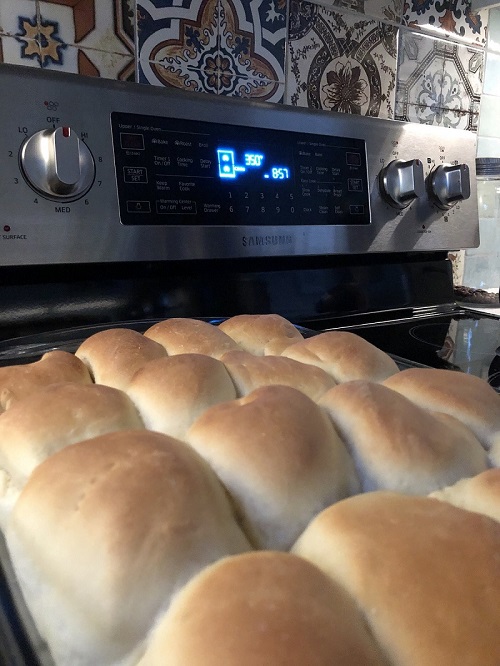Bread is good for the soul

Photo by Lesli Christianson-Kellow
My fingers brushed against a single small packet of yeast that I had thrown in the back of the cupboard earlier this spring. My friend had placed the packet in my hand, looked at me with pity and suggested that I try baking bread as a means of relaxation. Maybe, I had said, but I thought to myself, who had time to bake bread?
I had time a few weeks ago. I needed an outlet and it had come down to baking bread. I searched out a recipe online and found one that sounded promising – ‘Russell’s Grandma’s 2-hour Buns’. I didn’t know who Russell was, but I was pretty sure his Grandma would know what she was doing when it came to baking bread.
I gathered the ingredients: flour, sugar, yeast, salt, water, oil, and an egg.
I wanted to make the buns so they would be ready in time for dinner. I looked at the clock, it was going to be close. I quickly threw the dry ingredients into one bowl, the wet ingredients into another. Hastily, I combined the two textures. It was so sticky.
Then I kneaded the dough on the countertop for five minutes, like the recipe said. It was still sticky, but I didn’t have time to knead it anymore. It was time to place the ball of dough in a bowl to rise, as the recipe instructed.
I was making dinner rolls to go with the lentil soup I had made earlier. A perfect match. The recipe said that it was time to punch the dough down and then let it rise for another 15 minutes. I wasn’t sure what punching was, but attacked the dough quite literally. Maybe this was the stress-relieving part? The recipe said to let it rise again. Then I punched it down again.
The dough was hard and sticky. I looked at the clock again. The recipe said to divide the dough into balls. I rolled out 16 balls and placed them into a 9×13 inch baking dish. I had to read the next instruction three times – cover with a tea towel and let rise for about one hour. One hour? Was there time to make these buns before supper?
After an hour I peeked under the tea towel and was instantly disappointed. The buns had not risen at all. They were still the same size. I re-read the recipe and checked off the instructions in my head. I was frustrated.
I glanced at the clock. It was getting late, so I decided to go ahead and cook the dinner rolls anyways, despite them not rising. Hopefully, a miracle would happen in my oven. When the timer beeped 15 minutes later, I could see that the compact balls were still that same size, although brown.
Once the buns were cool, I cut through the rock hard exterior and patted on some butter. I took a bite – tough and chewy. They did not look fluffy like the picture of Russell’s Grandma’s buns. I looked over the recipe again. The yeast. The recipe called for instant yeast. I looked at the packet I had and realized it was traditional yeast.
I did a quick check on my computer and read that traditional yeast requires activation. If it is not activated with sugar and warm water, then the yeast will be useless. I had failed, but I was determined to get some dough therapy.
Within the week I was able to pick up some more yeast from a local bakery. It was traditional yeast, but now I knew what to do with it.
This time, I activated the yeast with warm water and sugar for five minutes. I was rewarded with yeast that bubbled and showed life. I carefully mixed the dry ingredients and the wet ingredients and then combined the two. I did this meditatively, gently and thoughtfully.
It made me think of one of my favourite books — Like Water For Chocolate by Laura Esquivel. Each chapter has the main character cooking a recipe. Each time she is feeling a different emotion – anger, sadness, elation – and as she cooks the emotion is transferred into her cooking.
Then when her dinner guests start eating her delicious dishes, they also start experiencing the emotions that she was experiencing while cooking. I sigh and realize that I am relaxing while kneading the dough. Maybe I will transfer some of these good vibes into Russell’s Grandma’s buns.
I noticed that the dough was coming together differently this time. I added extra flour as needed, creating a dough that was soft and smooth. I rolled it and kneaded it. I felt relaxed and peaceful and purposeful. Working with the dough actually made me feel calm.
I gently punched down the dough as required. Then I divided the dough into 4 chunks and then divided the four chunks into four pieces. I rolled each piece into a ball and placed each one into a 9×13 inch baking dish. I covered the pan with a clean tea towel and left the dough to rise.
I had no expectations, the worst outcome had already happened, so the outcome could only be better this time. After an hour, I was satisfied to see that the dough had pushed up against the tea towel.
I smiled and I slid the tray into the oven. When the timer beeped. I was amazed to see that the buns had stretched far beyond the confines of the baking pan. They were fluffy and lightly browned. The texture was soft and bouncy.
I prepared a bun with butter and bit into it. Immediately I felt a sense of satisfaction and peacefulness. Maybe there is something to baking bread.
As Miguel de Cervantes, a Spanish novelist and the creator of Don Quixote once said, “All Sorrows are Less with Bread.”
I think he might have been on to something.
